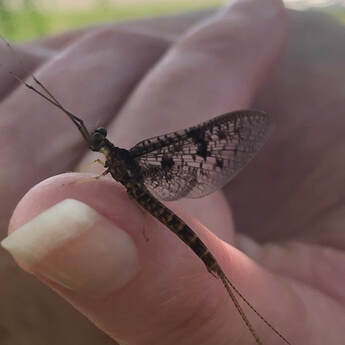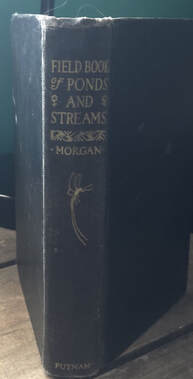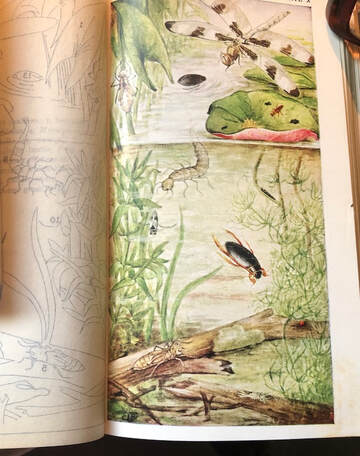|
6/28/2019 The Mayflies are Hatching It's almost the fourth of July and the mayflies have hatched in the Finger Lakes region - always a good sign. Mayflies have adapted to every aquatic situation except foul water - that is according to Anne Haven Morgan - aka Mayfly Morgan, known for her study of aquatic life in the early 1900s. I have a first edition copy of her book, titled Field Book of Ponds and Streams, published by Putnam in 1930. It contains over 250 illustrations and plates done by Morgan who was a Professor of Zoology at Mount Holyoke College. So popular was her little field guide it was used by students of Biology at Cornell University back in the day (personal communication from John Weeks, a naturalist from the area who attended Cornell in the 1930s).  Mayflies hatch in the early summer after spending most of their life as nymphs under water, breathing through gills found on their abdomen. When they reach adulthood, they climb up a stem or reed and molt (depending on the species it could take hours or days). They have no mouth parts but they have wings for flight. They don't eat at this stage; their only job is to procreate. The fishermen call them duns or spinners because of their mating flight that begins at twilight. They swing up and down in the air like the seeds of a cottonwood tree, flinging upwards of thirty feet. Hundreds of them will perform this dance over the water. Once done, the females dip their tails ever so delicately on the lake to lay their eggs. It looks like soft raindrops pattering on the surface. After the act is completed, the females die, forming mats on the surface, becoming food for ducks and fish. The males also have a short lifespan as adults. They mate and alight on the nearest tree where they spend for their final hours. Hence the Latin name given to the insects - Ephemeroptera - meaning ephemeral- short lived. Like our summers in the Finger Lakes. According to Morgan's field guide, Dr. F.H. Krecker observed so many dead mayflies after a hatch on the shores of Cedar Point, Lake Erie, that there were piles of them, six-eight inches deep under the street lights. The local amusement park had to haul their lacey bodies in carts each morning. Those must have been the days before industrial pollution and harmful algae blooms started choking the waters of the lake.  Anne Haven Morgan's Field Guide to Ponds and Streams Plate X Anne Haven Morgan's Field Guide to Ponds and Streams Plate X You can see how delicate these creatures are in the plate illustration from Morgan's field guide. At the very bottom, on a log to the right, is the nymph looking like a skeleton. The larger insect to the left is a dragonfly nymph (yes dragonflies spend their nymph stage under water as well and breath through gills inside their abdomen). I fell in love with mayflies when I first started studying aquatic science and collected them as part of stream studies. I even went so far as to include their life history in my novel set in the Finger Lakes after their Latin name - Ephemeral Summer. Their short life span is beautifully tragic, yet purposeful. Which in the scheme of things could be said about most living creatures. |
AuthorSheila Myers is an award winning author and Professor at a small college in Upstate NY. She enjoys writing, swimming in lakes, and walking in nature. Not always in that order. Archives
April 2024
CategoriesAll Adirondacks Algonquin Appalachia Award Cades Cove Canada Chestnut Trees Christmas Civilian Conservation Corps Collis P. Huntington Creativity Doc Durant Durant Family Saga Emma Bell Miles Finger Lakes Great Depression Hell On Wheels Historical Fiction History Horace Kephart Imagination National Parks Nature Publishing Review Screenplay Short Story Smoky Mountains Snow Storm Stone Canoe Literary Magazine Thomas Durant Timber Wilderness World War II Writing |
|
|
All materials Copyright 2022
Any reproduction, reprint or publication without written consent of author prohibited. |
 RSS Feed
RSS Feed